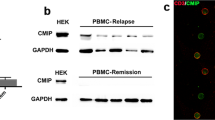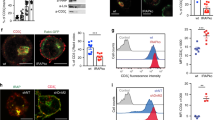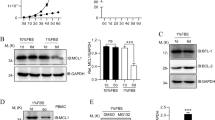Abstract
Sustained calcium signaling induces a state of anergy or antigen unresponsiveness in T cells, mediated through calcineurin and the transcription factor NFAT. We show here that Ca2+-induced anergy is a multistep program that is implemented at least partly through proteolytic degradation of specific signaling proteins. Calcineurin increased mRNA and protein of the E3 ubiquitin ligases Itch, Cbl-b and GRAIL and induced expression of Tsg101, the ubiquitin-binding component of the ESCRT-1 endosomal sorting complex. Subsequent stimulation or homotypic cell adhesion promoted membrane translocation of Itch and the related protein Nedd4, resulting in degradation of two key signaling proteins, PKC-θ and PLC-γ1. T cells from Itch- and Cbl-b–deficient mice were resistant to anergy induction. Anergic T cells showed impaired calcium mobilization after TCR triggering and were unable to maintain a mature immunological synapse, instead showing late disorganization of the outer ring containing lymphocyte function–associated antigen 1. Our results define a complex molecular program that links gene transcription induced by calcium and calcineurin to a paradoxical impairment of signal transduction in anergic T cells.
This is a preview of subscription content, access via your institution
Access options
Subscribe to this journal
Receive 12 print issues and online access
$209.00 per year
only $17.42 per issue
Buy this article
- Purchase on Springer Link
- Instant access to full article PDF
Prices may be subject to local taxes which are calculated during checkout






Similar content being viewed by others
References
Hunter, T. Protein kinases and phosphatases: the yin and yang of protein phosphorylation and signaling. Cell 80, 225–236 (1995).
Sun, H., Charles, C.H., Lau, L.F. & Tonks, N.K. MKP-1 (3CH134), an immediate early gene product, is a dual specificity phosphatase that dephosphorylates MAP kinase in vivo. Cell 75, 487–493 (1993).
Hershko, A. & Ciechanover, A. The ubiquitin system. Annu. Rev. Biochem. 67, 425–479 (1998).
Sorkin, A. & Von Zastrow, M. Signal transduction and endocytosis: close encounters of many kinds. Nat. Rev. Mol. Cell. Biol. 3, 600–614 (2002).
Valitutti, S., Muller, S., Salio, M. & Lanzavecchia, A. Degradation of T cell receptor (TCR)-CD3-zeta complexes after antigenic stimulation. J. Exp. Med. 185, 1859–1864 (1997).
Schwartz, R.H. T cell anergy. Annu. Rev. Immunol. 21, 305–334 (2003).
Macian, F., Lopez-Rodriguez, C. & Rao, A. Partners in transcription: NFAT and AP-1. Oncogene 20, 2476–2489 (2001).
Macian, F. et al. Transcriptional mechanisms underlying lymphocyte tolerance. Cell 109, 719–731 (2002).
Monks, C.R., Freiberg, B.A., Kupfer, H., Sciaky, N. & Kupfer, A. Three-dimensional segregation of supramolecular activation clusters in T cells. Nature 395, 82–86 (1998).
Grakoui, A. et al. The immunological synapse: a molecular machine controlling T cell activation. Science 285, 221–227 (1999).
Huppa, J.B., Gleimer, M., Sumen, C. & Davis, M.M. Continuous T cell receptor signaling required for synapse maintenance and full effector potential. Nat. Immunol. 4, 749–755 (2003).
Lee, K.H. et al. T cell receptor signaling precedes immunological synapse formation. Science 295, 1539–1542 (2002).
Murphy, L.O., Smith, S., Chen, R.H., Fingar, D.C. & Blenis, J. Molecular interpretation of ERK signal duration by immediate early gene products. Nat. Cell. Biol. 4, 556–564 (2002).
Lee, K.H. et al. The immunological synapse balances T cell receptor signaling and degradation. Science 302, 1218–1222 (2003).
Fang, D. et al. Dysregulation of T lymphocyte function in itchy mice: a role for Itch in TH2 differentiation. Nat. Immunol. 3, 281–287 (2002).
Naramura, M. et al. c-Cbl and Cbl-b regulate T cell responsiveness by promoting ligand- induced TCR down-modulation. Nat. Immunol. 3, 1192–1199 (2002).
Anandasabapathy, N. et al. GRAIL: an E3 ubiquitin ligase that inhibits cytokine gene transcription is expressed in anergic CD4+ T cells. Immunity 18, 535–547 (2003).
Katzmann, D.J., Odorizzi, G. & Emr, S.D. Receptor downregulation and multivesicular-body sorting. Nat. Rev. Mol. Cell. Biol. 3, 893–905 (2002).
Perry, W.L. et al. The itchy locus encodes a novel ubiquitin protein ligase that is disrupted in a18H mice. Nat. Genet. 18, 143–146 (1998).
Chiang, Y.J. et al. Cbl-b regulates the CD28 dependence of T-cell activation. Nature 403, 216–220 (2000).
Bachmaier, K. et al. Negative regulation of lymphocyte activation and autoimmunity by the molecular adaptor Cbl-b. Nature 403, 211–216 (2000).
Healy, J.I. et al. Different nuclear signals are activated by the B cell receptor during positive versus negative signaling. Immunity 6, 419–428 (1997).
Glynne, R. et al. How self-tolerance and the immunosuppressive drug FK506 prevent B-cell mitogenesis. Nature 403, 672–676 (2000).
Irvin, B.J., Williams, B.L., Nilson, A.E., Maynor, H.O. & Abraham, R.T. Pleiotropic contributions of phospholipase C-γ1 (PLC-γ1) to T- cell antigen receptor-mediated signaling: reconstitution studies of a PLC-γ1-deficient Jurkat T-cell line. Mol. Cell. Biol. 20, 9149–9161. (2000).
Wells, A.D. et al. Regulation of T cell activation and tolerance by phospholipase Cγ-1-dependent integrin avidity modulation. J. Immunol. 170, 4127–4133 (2003).
Kaji, T., Hachimura, S., Ise, W. & Kaminogawa, S. Proteome analysis reveals caspase activation in hyporesponsive CD4 T lymphocytes induced in vivo by the oral administration of antigen. J. Biol. Chem. 278, 27836–27843 (2003).
Rizo, J. & Sudhof, T.C. C2-domains, structure and function of a universal Ca2+-binding domain. J. Biol. Chem. 273, 15879–15882 (1998).
Rotin, D., Staub, O. & Haguenauer-Tsapis, R. Ubiquitination and endocytosis of plasma membrane proteins: role of Nedd4/Rsp5p family of ubiquitin-protein ligases. J. Membr. Biol. 176, 1–17 (2000).
Plant, P.J. et al. Apical membrane targeting of Nedd4 is mediated by an association of its C2 domain with annexin XIIIb. J. Cell. Biol. 149, 1473–1484 (2000).
Seto, E.S., Bellen, H.J. & Lloyd, T.E. When cell biology meets development: endocytic regulation of signaling pathways. Genes Dev. 16, 1314–1336 (2002).
Katzmann, D.J., Babst, M. & Emr, S.D. Ubiquitin-dependent sorting into the multivesicular body pathway requires the function of a conserved endosomal protein sorting complex, ESCRT-I. Cell 106, 145–155 (2001).
Rao, N., Dodge, I. & Band, H. The Cbl family of ubiquitin ligases: critical negative regulators of tyrosine kinase signaling in the immune system. J. Leukoc. Biol. 71, 753–763 (2002).
Dustin, M.L., Bromley, S.K., Kan, Z., Peterson, D.A. & Unanue, E.R. Antigen receptor engagement delivers a stop signal to migrating T lymphocytes. Proc. Natl. Acad. Sci. USA 94, 3909–3913 (1997).
Negulescu, P.A., Krasieva, T.B., Khan, A., Kerschbaum, H.H. & Cahalan, M.D. Polarity of T cell shape, motility, and sensitivity to antigen. Immunity 4, 421–430 (1996).
Dustin, M.L. & Springer, T.A. T-cell receptor cross-linking transiently stimulates adhesiveness through LFA-1. Nature 341, 619–624 (1989).
Sun, Z. et al. PKC-θ is required for TCR-induced NF-κB activation in mature but not immature T lymphocytes. Nature 404, 402–407 (2000).
Yokoi, N. et al. Cblb is a major susceptibility gene for rat type 1 diabetes mellitus. Nat. Genet. 31, 391–394 (2002).
Courbard, J.R. et al. Interaction between two ubiquitin-protein isopeptide ligases of different classes, CBLC and AIP4/ITCH. J. Biol. Chem. 277, 45267–45275 (2002).
Kowanetz, K. et al. Identification of a novel proline-arginine motif involved in CIN85-dependent clustering of Cbl and downregulation of EGF receptors. J. Biol. Chem. 278, 39735–39746 (2003).
Lechner, O. et al. Fingerprints of anergic T cells. Curr. Biol. 11, 587–595 (2001).
Korthauer, U. et al. Anergic T lymphocytes selectively express an integrin regulatory protein of the cytohesin family. J. Immunol. 164, 308–318 (2000).
Kolanus, W. et al. αLβ2 integrin/LFA-1 binding to ICAM-1 induced by cytohesin-1, a cytoplasmic regulatory molecule. Cell 86, 233–242 (1996).
Boussiotis, V.A., Freeman, G.J., Berezovskaya, A., Barber, D.L. & Nadler, L.M. Maintenance of human T cell anergy: blocking of IL-2 gene transcription by activated Rap1. Science 278, 124–128 (1997).
Reedquist, K.A. et al. The small GTPase, Rap1, mediates CD31-induced integrin adhesion. J. Cell. Biol. 148, 1151–1158 (2000).
Sebzda, E., Bracke, M., Tugal, T., Hogg, N. & Cantrell, D.A. Rap1A positively regulates T cells via integrin activation rather than inhibiting lymphocyte signaling. Nat. Immunol. 3, 251–258 (2002).
Katagiri, K. et al. Rap1 is a potent activation signal for leukocyte function-associated antigen 1 distinct from protein kinase C and phosphatidylinositol-3-OH kinase. Mol. Cell. Biol. 20, 1956–1969 (2000).
Katagiri, K., Hattori, M., Minato, N. & Kinashi, T. Rap1 functions as a key regulator of T-cell and antigen-presenting cell interactions and modulates T-cell responses. Mol. Cell. Biol. 22, 1001–1015 (2002).
Suga, K. et al. CD98 induces LFA-1-mediated cell adhesion in lymphoid cells via activation of Rap1. FEBS Lett. 489, 249–253 (2001).
Ishida, D. et al. Antigen-driven T cell anergy and defective memory T cell response via deregulated Rap1 activation in SPA-1-deficient mice. Proc. Natl. Acad. Sci. USA 100, 10919–10924 (2003).
Fang, D. et al. Dysregulation of T lymphocyte function in itchy mice: a role for Itch in TH2 differentiation. Nat. Immunol. 3, 281–287 (2002).
Gajewski, T.F., Qian, D., Fields, P. & Fitch, F.W. Anergic T-lymphocyte clones have altered inositol phosphate, calcium, and tyrosine kinase signaling pathways. Proc. Natl. Acad. Sci. USA 91, 38–42 (1994).
Khoshnan, A., Bae, D., Tindell, C.A. & Nel, A.E. The physical association of protein kinase C theta with a lipid raft-associated inhibitor of κB factor kinase (IKK) complex plays a role in the activation of the NF-κB cascade by TCR and CD28. J. Immunol. 165, 6933–6940 (2000).
Grynkiewicz, G., Poenie, M. & Tsien, R.Y. A new generation of Ca2+ indicators with greatly improved fluorescence properties. J. Biol. Chem. 260, 3440–3450 (1985).
Acknowledgements
We thank members of the Rao and Dustin laboratories for discussions, and T. Starr for the preparation of ICAM-1 and I-Ek for planar bilayer experiments. We also thank A. Altman, H. Band, J. Brugge, C. Joazeiro, M. Katan for advice and reagents. Supported by National Institutes of Health grants RO1-AI48213, RO1-AI40127 and RO3-HD39685 (to A.R.), RO1-AI50280 and R21-AI48542 (to Y.-C.L.) and AI-43542; an Irene Diamond Foundation grant (to M.L.D.); EMBO (V.H.); and the Cancer Research Institute (S.-H.I. and S.F.).
Author information
Authors and Affiliations
Corresponding author
Ethics declarations
Competing interests
The authors declare no competing financial interests.
Supplementary information
Rights and permissions
About this article
Cite this article
Heissmeyer, V., Macián, F., Im, SH. et al. Calcineurin imposes T cell unresponsiveness through targeted proteolysis of signaling proteins. Nat Immunol 5, 255–265 (2004). https://doi.org/10.1038/ni1047
Received:
Accepted:
Published:
Issue Date:
DOI: https://doi.org/10.1038/ni1047
This article is cited by
-
Th2 polarization in target organs is involved in the alleviation of pathological damage mediated by transplanting granulocyte colony-stimulating factor-primed donor T cells
Science China Life Sciences (2021)
-
Recent insights of T cell receptor-mediated signaling pathways for T cell activation and development
Experimental & Molecular Medicine (2020)
-
Defining ‘T cell exhaustion’
Nature Reviews Immunology (2019)
-
Integrative proteomics reveals an increase in non-degradative ubiquitylation in activated CD4+ T cells
Nature Immunology (2019)
-
Immune regulation by protein ubiquitination: roles of the E3 ligases VHL and Itch
Protein & Cell (2019)



